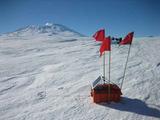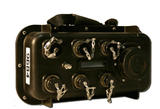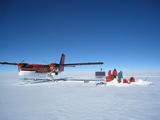
For summer only deployments, special and costly, heavy insulation is not needed since the temperature at that time of the year remains high enough that the electronic equipment and batteries will continue to operate normally without a heat source.
The PASSCAL Polar Group's summer only enclosures are made of molded, heavy-duty, lightweight polyethylene on the outside and have closed cell foam liner inside, cut to accommodate the equipment and batteries. They were designed with portability in mind and their outside dimensions are 24 in x 21 in x 11 in.
To ease deployment, the case was designed to contain all the equipment necessary as long as the sensor is an L28 or smaller. At the site, only the seismometer needs to be installed and the solar panel needs to be mounted on top of the case.





